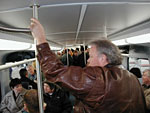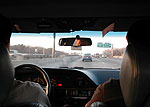By Tim Post
Minnesota Public Radio
April 8, 2002
The stretch of land between the Twin Cities and St. Cloud is one of the fastest growing in the country. And while the growth brings new economic viability to many communities, it also means frustration for commuters.
Minnesota transportation officials are looking for ways to alleviate the congestion. One solution is an 80-mile train line linking the St. Cloud area with Minneapolis. Backers of the Northstar commuter rail line say the project is a bargain compared to building roads. But opponents say its nearly $300 million price tag is too expensive, and favor spending money on other things.
| |
|
|
|
||
Five days a week, St. Cloud residents Todd McKee and Brian Kivel drive to their jobs at Firstar Bank in St. Paul. Kivel and McKee commute 700 miles a week, more than 33,000 a year. And they have the commuter war stories to prove it.
There was time they saw a drive eating a bowl of cereal, in stop-and-go traffic. Or the time they drove in the ditch, to avoid being hit by a truck. They say commuting is a pain, but they put up with it. Housing is cheaper in St. Cloud and they both have wives and children who don't want to move.
Drivers will encounter more commuting hassles as they travel between St. Cloud and the Twin Cities in coming years. More people are moving into the Highway 10 and Interstate 94 corridor that runs from Minneapolis to St. Cloud. Many of those new residents spend rush hour travelling to their jobs in the Twin Cities. Some Minnesota transportation officials say the answer to the area's increasing traffic problem is commuter rail.
Supporters of the Northstar rail line hope that within four years, commuter trains will carry 5,000 passengers in the morning, and 5,000 in the evening, back and forth between towns from St. Cloud to Minneapolis. They say it will cost $3 million a mile to construct Northstar.
| |
|
|
|
||
They compare that to the $30 million price tag for every mile of new highway construction. Northstar project director Tim Yantos says the rail line would give commuters a safe and convenient way to get to work.
"What we'd like to see are people making decisions as to what makes sense for them to move where they want to move, that time of the morning. Commuter rail will hopefully be operating, hopefully will be able to take well over 10,000 people off the roads. We hope to have people get to a location where they are rested and less stressed so they are able to spend more time with their family," Yantos says.
Northstar supporters say communities stand to gain from Northstar too; communities like Elk River. The proposed Northstar project plants a commuter rail station just a few miles south of the city's downtown.
Jeff Gongol, president of the Elk River Chamber of Commerce, says commuter rail means more people could live in Elk River, buy homes, and commute to their jobs in the Twin Cities. And Gongol says most downtown business owners think commuter rail would bring more customers to their door.
"The good thing about the corridor project, physically, is it goes right through town so people will be able to see our downtown when they go through and recognize it on their way back when they come back to spend their money," he says.
But not everyone in Elk River is sold on the promise of commuter rail.
|
"We hope to have people get to a location where they are rested and less stressed so they are able to spend more time with their family."
- Tim Yantos, Northstar project director Listen to more |
Some business owners are not convinced Northstar will be a good deal for the town. They feel unsure about future funding of the rail line. Gongol doesn't want to see local communities foot the bill for Northstar's operation.
"How will it be funded? We have a general idea, but we don't want to put the burden back on the local folks necessarily. This is a project that has statewide significance," according to Gongol.
Gongol is afraid the subsidies required to keep commuter rail running, could outweigh its benefits. Northstar supporters say the project will cost $294 million to build. Half of that would be paid for by the federal government. The rest would be picked up by the state and counties and cities up and down the corridor. On top of the upfront costs, it'll take $15 million a year to to operate the line. Of that, $10 million will be paid for by the state and federal government.
Some transportation experts are concerned about Northstar's price tag, and its reliance on subsidies. David Levinson, an assistant professor in the civil engineering department at the University of Minnesota, says taxpayers across Minnesota will pay to build Northstar, and they won't get any payback.
"That money is a one-time fee that we are going to have to spend as residents of Minnesota, which will never be paid back to them in terms in real terms, but not even in terms of the economic gains, or the time savings, or any of the other things that transportation is supposed to do," according to Levinson.
Levinson says Northstar would benefit only a few thousand people. He says even though 5,000 riders would use Northstar a day, only a few hundred commuters would use the line in its northern reaches. He thinks new roads - although more expensive - would serve more people.
Northstar supporters say ridership figures will go up as the population of the area grows. They counter criticism of using subsidies for the line's operation saying Minnesotan's subsidize roads too, everytime they fill up with gas.
| |
|
|
|
||
Critics' opinions aside, it's the Minnesota Legislature that will determine the future of Northstar. Gov. Ventura, who supports Northstar, proposed $120 million in bonding to cover the state's share of construction costs.
Ventura says if the state doesn't put up the money, the Federal Transit Administration will withdraw its offer to pay for the other half. Supporters say if the state rejects the feds offer to pay half, it will kill Northstar.
So far legislators have been unsympathetic. In its bonding bill, the Senate offered Northstar only $8 million. The House offered nothing, using bonding money instead to pay for road construction.
St. Cloud commuters Todd McKee and Brian Kivel say even if Northstar is built, they probably won't use it. Since Northstar would drop commuters off in Minneapolis, and they work in St. Paul, driving is their best option. But Brian Kivel says as traffic continues to grow, if he doesn't move closer to the Twin Cities, he might have to find a new job that doesn't require such a long commute.
"Right now it's not bad, but in five, 10 years it could be bad and we need to see if MnDOT is going to make improvements to the roads. If it gets to the point where the commute is adding another 20 minutes on, then I'm definitely going to seek other options." Kivel says.
Kivel and McKee say they don't know what would fix traffic congestion between St. Cloud and Minneapolis. They say even if commuter rail is put in place, or more traffic lanes are built, they doubt traffic will ease up. They're resigned to the fact that heavy traffic is spreading from the Twin Cities, and it's going to be difficult just to keep ahead of it.
More from MPRMore Information



